10 tips for better nature photography
- WildWillowWays

- Jan 20, 2021
- 4 min read
Updated: Jun 23, 2021
When I take a look back over my images I find that quite a sizeable majority of them are nature photographs of one kind or another. I seem to be naturally drawn to this genre of photography, particularly as it can encompass most of what I want to do in photography.
While landscape photography is a genre in itself and needs a greater amount of sophisticated lenses than I have, I can still do small scale landscape photography while also taking in close-up and even macro photography, make use of a number of different types of lenses and even take smartphone images when I have no other camera available.
Nature photography can include images of flowers, trees, insects, birds, plants and hedgerows, in fact anything that is naturally occurring can fall into this photography genre.
According to Wikipedia, nature photography “is a wide range of photography taken outdoors and devoted to displaying natural elements such as landscapes, wildlife, plants, and close-ups of natural scenes and textures.”
Based on my experiences I have drawn up a list of ten tips for nature photography which you may find useful.
1. Become more observant
Nature photography encourages us to become more observant but also requires us to be observant – to notice changing cloud patterns in the sky, the effect of raindrops on a plant, an unusual or interesting species, something growing in an unexpected place.




2. Don’t fret over photography gear
Some types of photography require certain types of lenses in order to capture the best images, and these are invariably expensive. Nature photography has something for everyone in that we can capture great images in nature with whatever equipment we have at hand or adjust our images to suit whatever gear we have available.

This image was captured with my mobile phone on a beach...no, it's not a snake!
3. Isolate the subject
The best nature images are achieved by choosing a definite subject and isolating it from its background so that it stands out for the viewer. Whether it is a fabulous waterfall or a tiny petal, the image will be more effective if we know exactly what we are looking at. In this way both aperture priority and shutter priority can be utilized according to the particular context, but even with a smartphone I can isolate the subject from its surroundings to showcase a particular aspect of nature.



4. Take a close up view
Focusing on small subjects such as stones, shells, petals, leaves or small details of larger subjects can make for interesting nature images, as can focusing more closely on patterns and textures.



5. Get a new perspective
This is something that I have tried a number of times with varying degrees of success. I get down low and shoot with a ‘snail’s eye view’ or isolate a subject by shooting up towards the sky. Sometimes I try to get in close and fill the frame. I find that every photography opportunity has many perspectives and it is important not to confine myself to the most obvious one.




At times, placing the phone camera on the ground and shooting from that level can give a perspective not usually seen.
6. Take in textures
Rich textures abound in nature and they provide numerous opportunities for the nature photographer to experiment with the capture of rough, smooth, shiny, soft, gritty, and so on, as they occur in nature.


7. Look for patterns
Patterns in nature make interesting images, and patterns are to be found everywhere. Patterns provide subjects for close up shots, which are visually appealing, while recurring patterns or repetition of elements add a touch of uniqueness to an otherwise average image.


8. Be aware of light
Photography is all about using light and the best light is provided by nature itself. That being said, there are obviously some times that produce better light conditions for photography. In my own case, I haven’t yet captured nearly enough images in the times around sunrise and sunset so I look forward to harnessing those opportunities in the coming months. My intention is to return to some of the places in which I captured a subject I liked which could be improved by capturing the subject in different light conditions.

I was lucky to grab this image when the sun was falling on the side of the mountain.

9. Enjoy all that nature has to offer
Perhaps one of the most important features of nature photography is not the images we bring back but the amount of enjoyment we have in taking them. Being outside in the fresh air regardless of weather, noticing things around us, particularly small things not often seen, can bring with it a sense of contentment and a lack of hurry. While I try to make good images, I know that nature doesn’t mind if they are not perfect, as nature itself is not perfect. Some aspects of nature may not look their best in certain seasons but that is how they are and they can still make good images. Nature gives a lot to the photographer, not just in the form of photographs.



The final tip speaks for itself.
10. Leave no trace, and take away nothing but a photograph!
Unless it's plastic!

Updated January 2021






Thank you for your positive comments, Ian. Much appreciated.
Excellent as usual Mary. Informative, entertaining and thoughtful. :-) If I had to pick a favourite from all the photos, I would have to go for either of the two texture ones.
Keep up the good work.
Ian
www.oldireland.ie